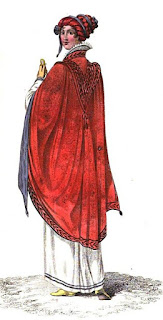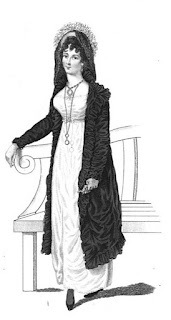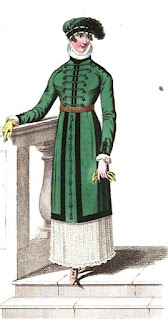This series of fashion blogs continues with a look at walking dress in the Regency period, using the fashion pages from
La Belle Assemblée in 1811, 1812 and 1816.
Spring 1811
 |
Regency walking dress
from La Belle Assemblée (Jan 1811) |
“A pelisse of scarlet Merino cloth, buttoned down the front and up the arm with small gold buttons; the collar and cuffs of purple velvet; but during the mourning, of black, striped with scarlet; an ermine tippet pointed in the back, and muffs of the same. A bonnet of scarlet cloth, turned up with velvet, and formed to come over the face; the veil passed through the front and brought round the neck. Boots of scarlet cloth trimmed with velvet.”
 |
Walking dress
from La Belle Assemblée (Mar 1811) |
|
“Round dress of cambric muslin, with a ruff collar, trimmed round the bottom with narrow purple ribband;
cassimere crimson mantle, confined close to the back, lined with purple silk, embroidered round the neck, cape, and sides with purple fancy border; a deep cape falling from the shoulders, sloping to a narrow point, with tassels. A crimson velvet bonnet, turban front and trimmed with purple to correspond. York tan gloves. Yellow kid boots.”
Spring 1812
 |
Walking dress
from La Belle Assemblée (Jan 1812) |
“A scarlet Merino cloth pelisse, lined with straw coloured sarsnet, trimmed with light coloured spotted fur, and attached with loops of black silk cordon and rich frog tassels; the broad fur in front, forming a tippet, pointed at the back. A narrow fur passes from the top of the sleeve, is brought down the side seams, and relieved by fastenings of black silk cordon; four loops with frogs ornament the shoulders and cuffs; plain standing up collar tied with cordon: a fine cashmere shawl, with brown ground, and richly variegated border, is generally thrown over the dress, in which is united both comfort and elegance. A Swedish hat of the same materials as the pelisse, lined with straw colour, and fastened up one side; the crown trimmed with two rows of narrow spotted fur, and one still narrower at the edge of the hat; a bunch of the Christmas holly in front, and tow tassels falling from the summit of the crown, of black, to answer the pelisse, which is worn over a white round dress, either of plain or corded cambric. Beaver gloves, and
demi-broquins of scarlet Morocco, laced with black, and lined with fur, complete the dress.”
A "demi-broquin" was a half-boot.
 |
Dress for the fashionable promenades
from La Belle Assemblée (Feb 1812) |
“A purple velvet pelisse, with a full standing-up collar, worn carelessly open over a round white dress of fine French cambric; the pelisse trimmed with a broad bordering of braided ribbon, the same colour as the velvet. A Minerva bonnet of amber coloured sarsnet, with a long white ostrich feather across the front; the feather made round, and very full; long black lace veil,
à la religieuse; a chain necklace, composed of pearls with a gold ornament depending in front, representing the Apollo Lyre, set round with a circle of pearls; a gold Lisbon chain with an eye glass hanging below the waist. Plain gold oval-ring pendants. Purple half boots and York tan gloves.”
 |
Morning walking dress
from La Belle Assemblée (Mar 1812) |
“A three quarters pelisse, of dark willow-green sarsnet, or fine Merino cloth, worn over a round dress of fine India muslin, richly embroidered, and trimmed round the bottom with lace, put on rather full. The pelisse made round in the skirt, like the short Indian coat; and trimmed round the throat and wrists with swansdown; faced in front and trimmed round the bottom with broad stripes of black velvet; military front, with two rows of mother-of-pearl buttons, fastened down the front of the skirt with one row of the same and alternate tassels, the colour of the pelisse, which is confined at the waist by a gold belt. Yeoman’s hat of the same colour, materials and ornaments as the pelisse, and finished in front with a flat ostrich feather. Half boots of light fawn coloured kid, laced with dark willow green in front. Limerick gloves of pale straw colour.”
Spring 1816
La Belle Assemblée does not include any fashion plates for walking dresses in the first three months of 1816, but the following excerpts from the fashion narrative give an indication of the outdoor wear that the haut ton were wearing:
La Belle Assemblée - January 1816:
“When Fashion, deprived of the treasures of Flora, binds the wintry wreath round the brow of Beauty, she then may be said to display the most magnificent splendours of her versatile empire. The ostrich lends her stately plumes, the finest wool of the Merino flocks are woven in beautiful texture, stained with colours of the richest dye, and diversified with patterns of the most elegant kind; while velvet, gold, and costly furs are brought forward to deck the fair forms of Britains’s unrivalled daughters. Merino cloth pelisses with pelerine capes, bound with a broad satin ribbon, are the most prevalent out-door costume for the fair pedestrians.”
La Belle Assemblée - February 1816:
“The extreme rigidity of the season has made but little difference in the out-door costume of our fair countrywomen. Fashion, has been, like every other mundane power, in a manner chain-bound by the frost, and the most warm and comfortable dress for the female pedestrian has, consequently, been that which is most in favour.”
“For walking costume, a plainer dress presents itself, generally of a dark bottle-green, with a sable or seal-skin hat, or Regency cap, adorned with band and tassels of gold, or of the same colour as the pelisse; others prefer the modest slate colour, with a large bunch of Dunstable chip or moss silk, the colour of the pelisse, and which latter is most prevalent; with this retired dress is worn a muff of swansdown or moss silk.”
Sources used include:
Bell, John,
La Belle Assemblée, various (1811-1816)






I'd imagine that the women must have been uncomfortably warm/hot in these outfits and perspired profusely. Do we know what they did to avoid body odour, if indeed they were away of it and took steps to avoid it?
ReplyDeleteI imagine the gentlemen would have had similar problems perhaps moreso.
Women wore sturdy undergarments which could be washed more frequently than their fragile outer garments. They used perfume to mask the odour rather than prevent its occurrence!
DeleteWhat a lovely column!
ReplyDeleteThank you for the detailed information and pictures. I found myself lingering over the photos of the portraits. Some look very much like acquaintances of mine!
Thanks again.
B.W.
Thank you :) We are very fortunate to have so many Regency era magazines online with such lovely plates.
DeleteDo you have photos of half boots? I have seen pictures of slippers, but am very curious about footwear designed for all the country walking that Lizzie Bennet and her sister did.
ReplyDeleteThere is a great article about half boots by Vic Sanborn on the Jane Austen's World website: http://janeaustensworld.wordpress.com/2011/03/09/regency-fashion-ladies-half-boots/
Delete